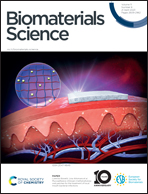Biodegradable photothermal thermosensitive hydrogels treat osteosarcoma by reprogramming macrophages†
Abstract
Osteosarcoma is one of the most common malignant tumors in children and tends to occur around the knee. Problems such as recurrence and metastasis are the outcomes of traditional treatment methods. One of the reasons for these issues is the infiltration of tumor-associated macrophages (TAMs) in the tumor microenvironment (TME). Photothermal immunotherapy has emerged as one of the most potent approaches for cancer treatment. In this study, we designed a biodegradable, injectable, and photothermal hydrogel that functions to reprogram TAMs into classically activated macrophages (M1) based on hydroxypropyl chitin (HPCH), tannic acid and ferric ions (HTA). We found that HTA had better photothermal efficiency than a pure hydrogel; its photothermal repeatability is good and it can be NIR (808 nm) irradiated as needed. In addition, the precooled hydrogel solution can be injected into the tumor and it can rapidly gel in situ. In vitro, HTA with NIR irradiation (HTA + NIR) induced the apoptosis of K7M2 cancer cells. In vivo, the local administration of HTA + NIR exerted photothermal killing of primary tumors and reprogramming of TAMs into M1-type macrophages in the TME. Therefore, the injectable photothermally active antitumor hydrogel has great potential for modulating the TME to treat bone tumors.



 Please wait while we load your content...
Please wait while we load your content...